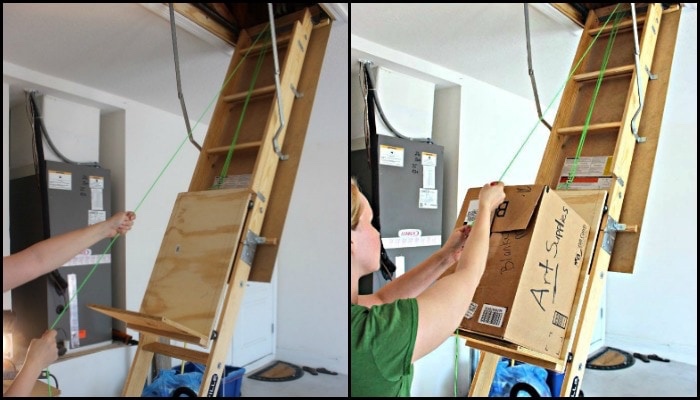Every homeowner knows the challenge of lifting heavy or bulky items up and down attic stairs, especially if it’s a garage attic where storage boxes, seasonal decorations, and more might be stashed away. Fortunately, with a simple DIY pulley system, you can eliminate the heavy lifting and make the task of using attic storage much more manageable. Here’s how you can create your own pulley system for those pull-down attic stairs.

Materials Needed:
- Heavy-duty pulley wheel: Ensure it can handle the weight of the items you plan to lift.
- Sturdy rope or cord: This should also be heavy-duty, with a weight limit exceeding your heaviest item.
- Hooks or brackets: For securing the pulley wheel to the attic entrance and the base of the stairs.
- Cleat or tie-down: For securing the rope after hoisting items.
- Storage platform or net: To place items on for hoisting.
Step-by-Step Guide:
1. Determine the Pulley Location:
Choose a spot at the top of your attic stairs to install the pulley wheel. This should be a beam or rafter that can handle the weight.
2. Secure the Pulley Wheel:
Attach your pulley wheel to the selected location using hooks or brackets. Ensure it’s securely fastened and can rotate freely.
3. Rope Installation:
Thread your rope or cord through the pulley wheel, ensuring it’s long enough to reach the bottom of your attic stairs with some excess.
4. Create a Lifting Platform:
Attach a storage platform or net to one end of the rope. This is where you’ll place items for hoisting. Ensure it’s secure and can handle the weight of your items.
5. Install a Cleat or Tie-Down:
On one side of the attic entrance, install a cleat or tie-down. This will be used to secure the rope, ensuring items remain suspended until you’re ready to lower them.
6. Test the System:
Before placing any heavy items on the platform, test the system with a light item to make sure everything works smoothly. Once you’re confident, you can start lifting more substantial items.
Safety Tips:
- Always double-check attachments: Ensure that all hooks, brackets, and other attachments are secured tightly.
- Weight limits: Don’t exceed the weight limits of your pulley, rope, or storage platform.
- Use gloves: When pulling the rope, wear gloves to prevent burns or blisters.
- Stay clear: Ensure that the area below the pulley is clear when hoisting or lowering items.
Choosing the Right Pulley System for Your Attic Stairs
Not all pulley systems are created equal, and selecting the right one for your attic stairs depends on weight capacity, ease of installation, and durability. Here’s what to consider when choosing a pulley system for your attic storage needs:
1. Weight Capacity
The first thing to determine is how much weight your pulley system needs to handle. If you plan on lifting heavy storage bins, tools, or even furniture, look for pulleys rated for at least 100–200 pounds. For lighter loads like seasonal decorations or clothing storage, a 50-pound capacity may be sufficient.
2. Type of Pulley System
There are a few different types of pulley setups you can use for attic stairs:
✔ Single Pulley – A simple setup that reduces effort but doesn’t provide much mechanical advantage. Best for lightweight items.
✔ Fixed Double Pulley – Offers a 2:1 mechanical advantage, meaning it reduces the lifting effort by half. Ideal for moderate loads.
✔ Compound Pulley System – Uses multiple pulleys to create a 4:1 or higher mechanical advantage, making it easier to lift heavier loads with minimal effort.
3. Rope or Cable Material
The lifting rope or cable should be strong, durable, and resistant to fraying. Consider using:
- Nylon rope – Affordable and strong, but can stretch under heavy loads.
- Braided polyester rope – Less stretch and more durability, ideal for long-term use.
- Steel cable – Extremely strong but requires a winch or crank for smooth operation.
4. Mounting and Safety Considerations
Ensure your pulley system is securely mounted to ceiling joists or attic framing. Using heavy-duty lag bolts or anchor points will prevent failures. If you’re lifting heavier items, consider adding a safety locking mechanism to prevent accidental drops.
Choosing the right pulley system saves time, reduces strain, and makes attic storage more efficient.
A pulley system for your attic stairs is an ingenious way to simplify the process of storing items in the attic. With a little bit of effort and some basic materials, you can set up a system that will serve you well for years to come, making attic storage not just more accessible but safer too.
Step-by-Step Guide to Installing Your DIY Pulley System
Once you’ve selected the best pulley system for your attic stairs, it’s time to install it. Follow these steps to create a safe and functional lifting setup:
Step 1: Gather Your Materials
You’ll need:
✔ Pulleys (single, double, or compound, depending on your needs)
✔ Heavy-duty rope or cable
✔ Ceiling-mounted anchor hooks or brackets
✔ Lag bolts and washers for secure attachment
✔ A storage platform (wooden board, crate, or netting)
✔ A winch or cleat for securing the rope
Step 2: Mount the Pulley System
- Locate a strong ceiling joist above your attic stairs to anchor the main pulley. Use a stud finder to ensure you attach it to solid wood.
- Drill pilot holes and secure the mounting brackets with lag bolts for maximum strength.
- Attach the pulleys to the brackets, ensuring they align directly above your lifting zone.
Step 3: Attach the Rope or Cable
- Feed the rope or cable through the pulley system, making sure it moves smoothly without tangling.
- Secure one end to the storage platform (such as a wooden board or reinforced net) that will hold your items.
- Attach the other end of the rope to a cleat, winch, or locking mechanism to prevent accidental slippage.
Step 4: Test the System
- Start by lifting a lightweight load to ensure the pulleys and rope move freely.
- Gradually increase the weight to confirm the system can handle your heaviest storage items.
- Adjust any rope tension, pulley alignment, or anchor points if needed.
Step 5: Secure the Rope When Not in Use
To keep the attic safe, always secure the rope to a cleat or wall-mounted hook when the system isn’t in use. If using a winch, ensure it has a locking mechanism to prevent unintentional movement.
With a properly installed DIY pulley system, lifting heavy attic storage becomes effortless and safe, making it easier to organize seasonal items without strain.
As an Amazon Associate we earn from qualifying purchases through some links in our articles.



